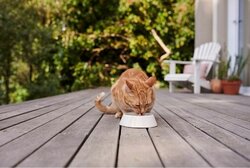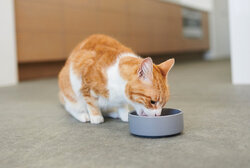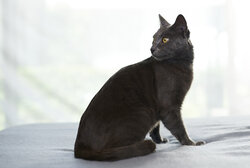Storing cat food
Cats place high demands on their food. Not only the composition of the food, but also its hygienic qualities are very important. Improper storage can lead to spoilage of the food, and can attract insects or cause changes in taste. Our tips will show you how to store cat food properly.
The perfect size reduces the need to stock up
Depending on how many cats you have at home and whether you give them wet or dry food, you will probably occasionally be faced with the problem of how to store it properly. This is relatively easy when it comes to wet food, because this is available in a variety of sizes, depending on the manufacturer. At animonda we provide you with a wide range of options, from 50g single-serve pouches and 100g trays to the popular 200g cans and large 800g cans. Many cat owners can therefore avoid the problem of storage, because they are able to choose the perfect size for one meal.
It is, however, not always that simple. Your favourite food may not be available in the exact size you require, or you may decide to save money and buy a can of wet food that will, for example, be enough for two meals per day. The question then arises of how to store it in the safest possible way.
With dry food, you will have to think about the right storage anyway, because a pack can last for several weeks. However, here too you at least have the option of choosing a size that avoids having to store the food for too long. Whatever the case, it is crucial that that you store it as safely as possible. Our tips will show you what you need to keep in mind.
Storing wet food
Wet food for cats is available in single-serve pouches, trays and cans. Single-serve pouches and trays are usually ideal for one portion, which is why the question of storage seldom arises. If it does, you can use a sealing clip for pouches and (soft) silicone keep-fresh lids for trays, which are also available in a square shape. Once opened, it is always important to seal the pack as air-tight as possible and to store it in the refrigerator.
With cans, it is much more common for them to not be used up all at once. You should make sure that they are only left open for a short time. Especially when it is warm, the texture of the food can change very quickly. This does not necessarily mean that it will go bad, but the taste can change and cats often respond very negatively to this. Imagine a liver sausage that you have left unsealed on the kitchen table for around five hours. You will see significant colour changes on the surface and you will also notice a change in taste. These changes are mainly due to oxygen and the outside temperature. Air and heat should be avoided as much as possible, which is why simply pressing the half-opened lid of the can back down is not enough. Instead, remove it completely, close the can tightly with a silicone lid and place it in the refrigerator.
A lid that is as airtight as possible is also important for another reason: cans are usually made of tinplate and are coated on the inside with tin to protect against corrosion. Although the body needs a certain amount of tin, too much of it can lead to, among other things, gastrointestinal problems. In the presence of oxygen, the tin can dissolve more easily and get into the food. For this reason, an open can should always be sealed with an optimally fitting lid and stored for a maximum of two days (in the refrigerator).
Tip:
A good alternative to the use of a lid on the can is to transfer the food to a different container. Use a glass jar or plastic box with a tight-fitting lid. This avoids any risk of corrosion. The only disadvantage is that you will always have to rinse the container thoroughly before using it again.
Storing dry food
Unopened, both dry food and wet food in general have a shelf life of over a year. The reason for this is that both are sealed so that they are airtight. As soon as you open a bag of dry food, air gets inside, which slowly but surely reduces the shelf life. If you have a large bag that you open every day to obtain your pet’s daily ration of dry food, this process will be speeded up. It is therefore advisable to pour a portion into a larger container that can be sealed airtight. You should immediately close the bag again (with as little air trapped inside as possible) and under no circumstances store it where sunlight can reach it. The place should be cool, dry and dark.
If you accidentally tear open the package of dry food too far or feel that it can no longer be properly closed, you should pour the entire contents into containers with screw caps or well-fitting plastic lids. A further advantage of this is that it avoids the cat being able to open a bag of food with its claws in order to help itself.
If you store dry food for too long and in the wrong way, you risk the following:
- The food becoming soft
The food gradually loses its crunchiness. This does not bother some cats, while others will then refuse to eat it.
- The food going bad
Dried food is packaged in as germ-free an environment as possible. However, as soon as the packaging is opened, it is exposed to oxygen, which causes oxidation to occur. Any antioxidants added may provide some protection, but a process is nevertheless set in motion. This affects, for example, the fats with which dry food is often sprayed. Over time, these can become rancid and cause the food to go bad.
- Mould and food mites
If stored incorrectly or for too long, storage mites and other pests can settle in and moulds can develop. These can lead to health problems and allergic reactions.
Ideally, avoid buying bags of dry food that will last for a long period of time. It is better to spend a little more and avoid the risk of the food going bad. Every now and then, pour out a supply of food from the larger bag into another container, remembering to rinse this out with hot water whenever it is empty. Under no circumstances should you keep refilling it, but instead use up all the food and clean it before adding a new portion.
You may also like this

Good cat food
How to recognize a good cat food

Dry or wet food?
Advantages and disadvantages of the different types of food

Feeding your cat
Tips on food and a healthy diet

Diabetes in cats
Cats too can suffer from elevated blood sugar levels

